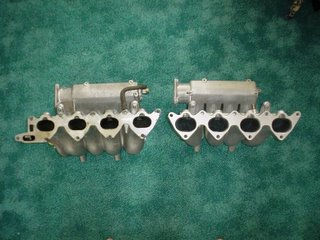




PLACE WHERE YOU CAN KNOW THE HEART OF YOUR LOVELY CAR.YOU WILL BE EXCITED TO KNOW THIS.COME AND LETS HAVE INFO. STAY TUNE.....

For those of you out there running big cams and a ported cylinder head, moving to a Mitsubishi Lancer GSR CD5A - 4G93T engine inlet manifold will give you slightly more top end. This is due to the shorter runner configuration on the 93T's inlet manifold. Picture below of the 93T inlet manifold. I bought the inlet manifold used from Ralliart Australia way back when this was a relatively unknown mod. To get the like new finish you have to brush the inlet manifold with a steel brush and use lots a engine degreaser/cleaner




The 4G61 displaces 1595 cc (82.3 x 75.0 mm bore/stroke). This engine was always DOHC 16-valve and used either Multi-point (MPFI) or Electronic Control (ECFI) fuel injection. A turbocharged version was also produced for the Mirage and Lancer. The 4G61 does not have balance shafts like the other 4G6x motors. Instead, it has different components, some of which can be used on the "Silent Shaft" engine.
Performance:
Applications:
The larger 1.8 L 4G62 was an SOHC 8-valve unit for longitudinal rear-wheel drive and all-wheel drive use. With an 80.6 x 88.0 mm bore / stroke, it displaced 1795 cc.
Applications:
The 4G63 was a 1997 cc version. (85mm Bore x 88 mm Stroke) SOHC and DOHC were produced. The DOHC version was introduced in 1987 in the Japanese market Galant VR-4 and came turbocharged or naturally aspirated. It is found in various models including the 1988-92 Galant VR-4 and the U.S. market 1990-1999 Eclipse, as well as the Mitsubishi Lancer Evolution I-IX.
The SOHC version was used in Mitsubishi Galant models until 1993. It has 76 kW of output and 157 NM of torque at 4750 rpm.
Also the SOHC version is produced until the late 90s and early 2000 and it is used in Mitsubishi cars like the Montero and the 2.0L 2-door Pajero with an output of 101kw at 4700 rpm. Also the N33 and N83 Spacewagon(UK market) in single cam 16 valve format.
The Mitsubishi Eclipse, Eagle Talon and Plymouth Laser introduced the DOHC turbocharged intercooled version to the U.S. in 1989 through Diamond Star Motors, a joint venture between Mitsubishi Motors and the Chrysler Corporation. From 1990 to late April 1992 came beefier rods and the use of 6 bolts to secure the flywheel to the crankshaft; May 1992 to 2006 Evolution versions have lighter rods and use 7 bolts to secure the flywheel to the crankshaft. They are referred to as the "six bolt" and "seven bolt" engines, respectively.
Output for the 2003 Japanese/US Mitsubishi Lancer Evolution is 271 hp (202 kW) at 6500 rpm with 273 ft·lbf (370 N·m) of torque at 3500 rpm. It has a cast iron engine block and aluminum DOHC cylinder head. It uses multi-point fuel injection, has 4 valves per cylinder, is turbocharged and intercooled and features forged steel connecting rods.
In the United Kingdom, a special Lancer Evolution, the FQ-400, produces 302.13 kW (405.2 hp), from a 4G63 engine. At 202.6 hp (151.3 kW) per liter, it has the highest specific output per liter of any production engine.
